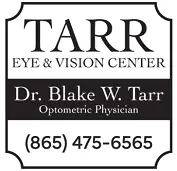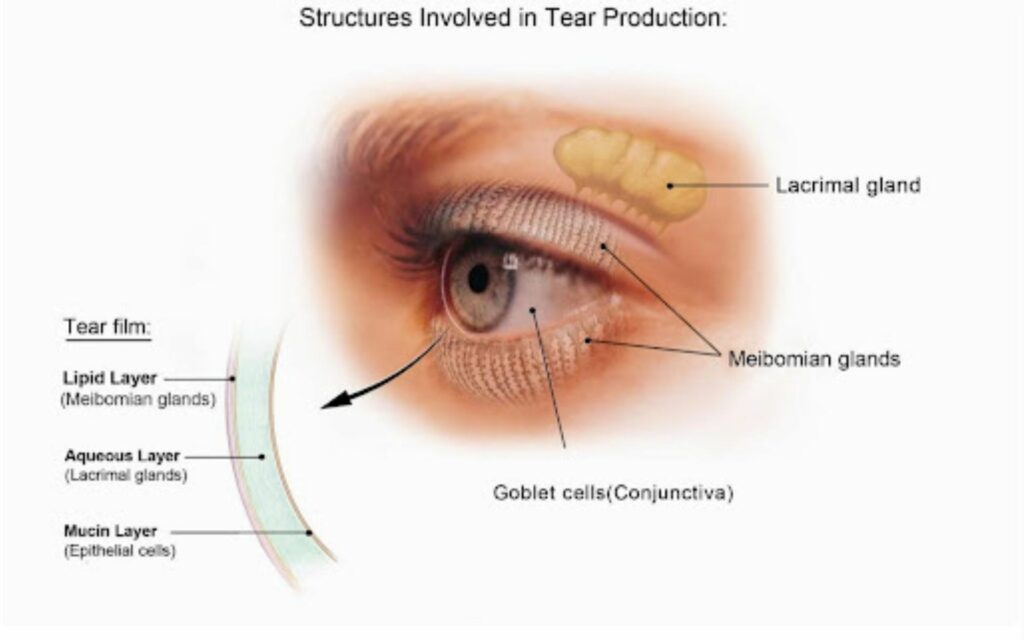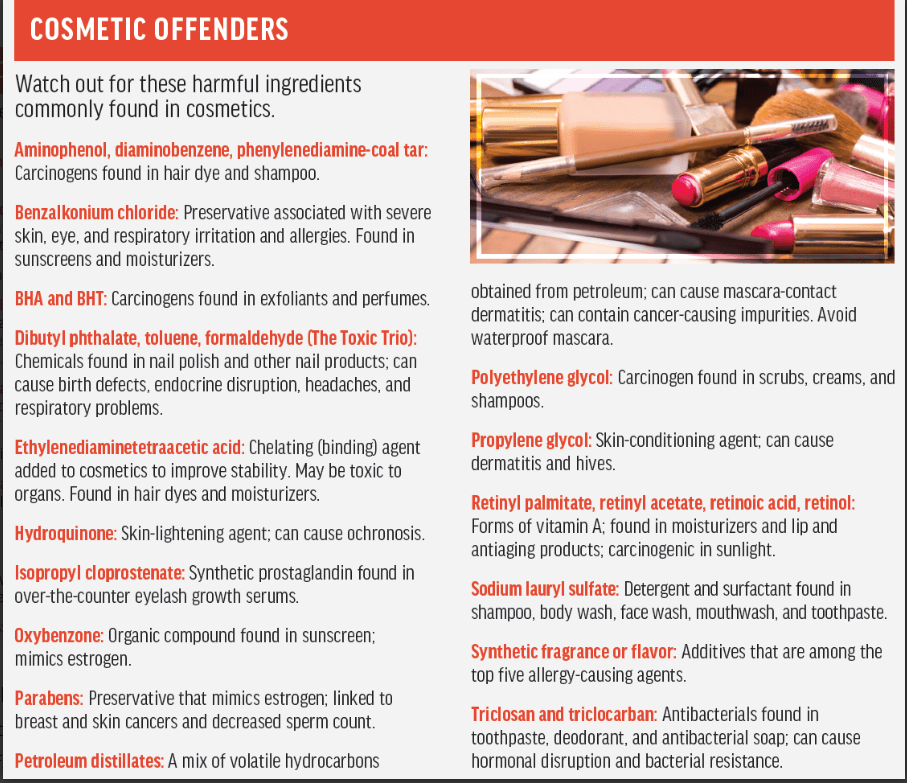Eye Disease Care
Eye Disease Management & Treatment
Dr. Blake Tarr uses cutting-edge technology to diagnose, treat, and manage a wide variety of diseases, including glaucoma, cataracts, diabetic retinopathy, macular degeneration, and pink eye. Many eye diseases develop without warning signs or symptoms. If not detected early and managed, these eye problems may lead to severe damage to your eye health and vision.
Eye Disease In America
Visiting for an eye exam is about more than just updating your eyeglass prescription. With more than 7 million Americans suffering from an eye disease that could cause vision loss or blindness, eye disease diagnosis is a key part of every exam.
To help protect the vision of our patients, we perform a series of tests during your exam. These tests can help us diagnose eye disease and recommend treatment and management options.
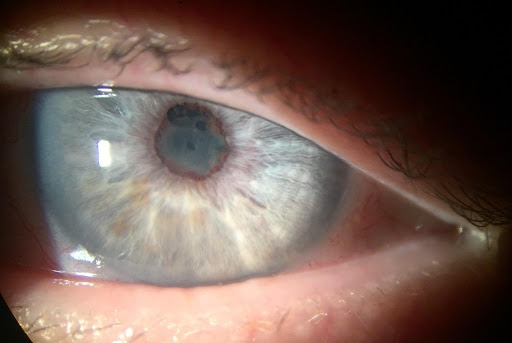
Natural & Holistic Eye Health
Taking care of your overall health and well-being can keep your eyes healthy and protect your vision.
Some useful tips for your daily routine are:

Eat Healthy
Good nutrition plays a vital part in your vision and eye health. Your eyes need vitamin A, found in carrots, vitamin C, Lutein and Zeaxanthin found in leafy green vegetables. Bioflavonoids, Vitamin E, minerals like Selenium, and essential fatty acids are also essential to eye health. At Tarr Eye & Vision Center we recommend you eat a balanced diet including plenty of green, leafy vegetables, fish, some nuts, and fresh fruits. A diet rich in these foods is good for your eyes and good for the rest of you too! Ask about vitamins specially formulated for your eyes.
Quit Smoking/Vaping
The chemicals in cigarettes, electronic cigarettes, and nicotine products can increase your risk of developing macular degeneration or cataracts.
Use Safety Glasses
If you work at a job where you use hazardous or airborne materials or play contact sports, protect your eyes from damage.


Wear Sunglasses
UV rays can cause irreversible damage to your eyes and increase your chances of developing cataracts.
Evaluate Your Digital Habits
Prevent digital eye discomfort, disruption of your sleep cycle, and eye development problems in children by practicing good usage habits while on digital devices.
Common eye Diseases
Age- related macular degeneration occurs when the central part of the retina, called the macula, deteriorates. AMD causes central vision loss, while peripheral (side) vision remains unaffected. Macular degeneration is the leading cause of severe vision loss in adults over age 50. Studies have found a genetic link to this disease. Women also tend to develop AMD at an earlier age than men. The major risk factors of this eye disease are age, genetics, obesity, smoking, high blood pressure, high cholesterol, and eating a diet high in saturated fat (found in foods like meat, butter, and cheese).
There are 2 types of AMD:
Dry AMD: This is the more common type affecting 80% of people with AMD. It occurs when the macula thins with age, causing tiny clumps of a protein called drusen to grow and block vision.
Wet AMD: This is the more serious type. Wet AMD occurs when abnormal blood vessels grow under the retina and leak blood into the eye, blocking vision and resulting in scarring of the macula.
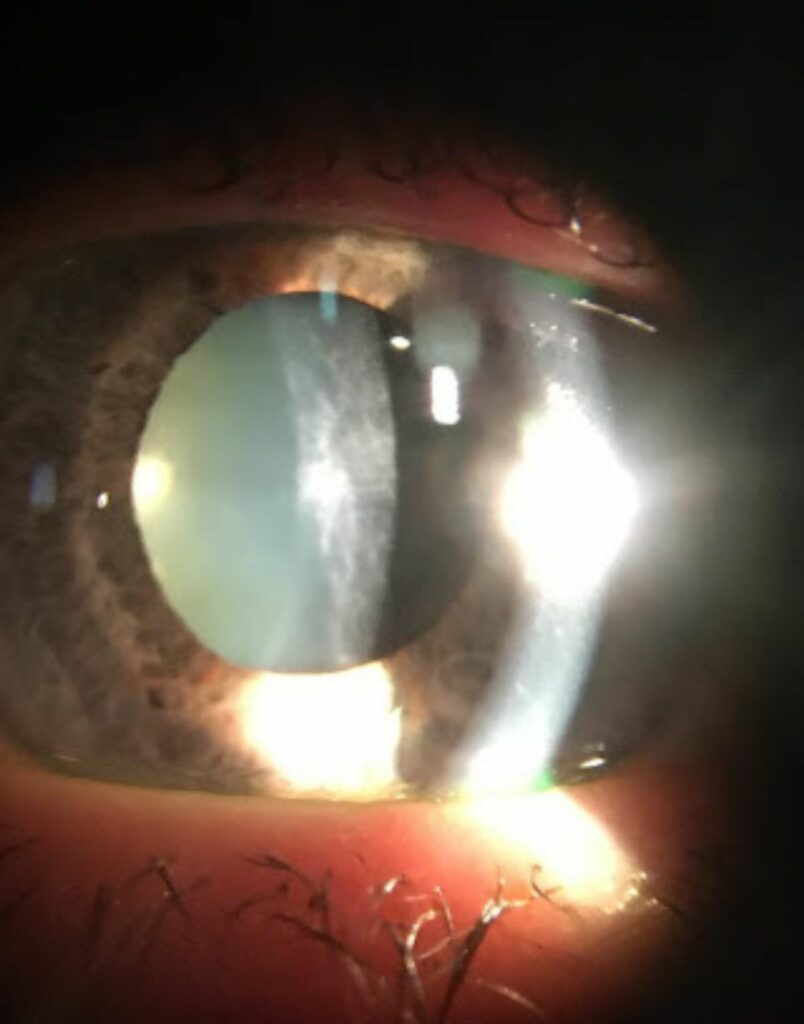
Cataracts commonly cause visual disability by blocking or blurring vision. A cataract forms when the clear lens inside your eye becomes cloudy. Cataracts can develop slowly over many years or rapidly progress over a few months. When a cataract is “ripe,” it can be easily treated with cataract surgery. However, being diagnosed with cataracts does not mean that you need to have surgery immediately, or maybe ever. You may be able to live with symptoms of early cataracts for a while by using vision aids such as glasses, anti-glare sunglasses, strong bifocals, magnification lenses or brighter lighting to suit your needs.
Surgery should be considered when the condition begins to seriously impair your vision to the extent that it affects your activities of daily life such as driving, reading, playing golf, playing cards, or watching TV. Sometimes surgery is also necessary if the cataracts are preventing treatment of another eye problem. Fortunately, cataract surgery is typically very successful in restoring your vision. Together with your eye doctor, you will decide if and when the time for surgery has arrived.
Some symptoms of cataracts are:
- Blurry or faded vision
- Double vision
- Film over your vision (that doesn’t go away with blinking)
- Halos or ghost images
- Increased Glare or sensitivity to light
- Poor night vision
- Requiring more light to read or finding it difficult to read in dim lighting
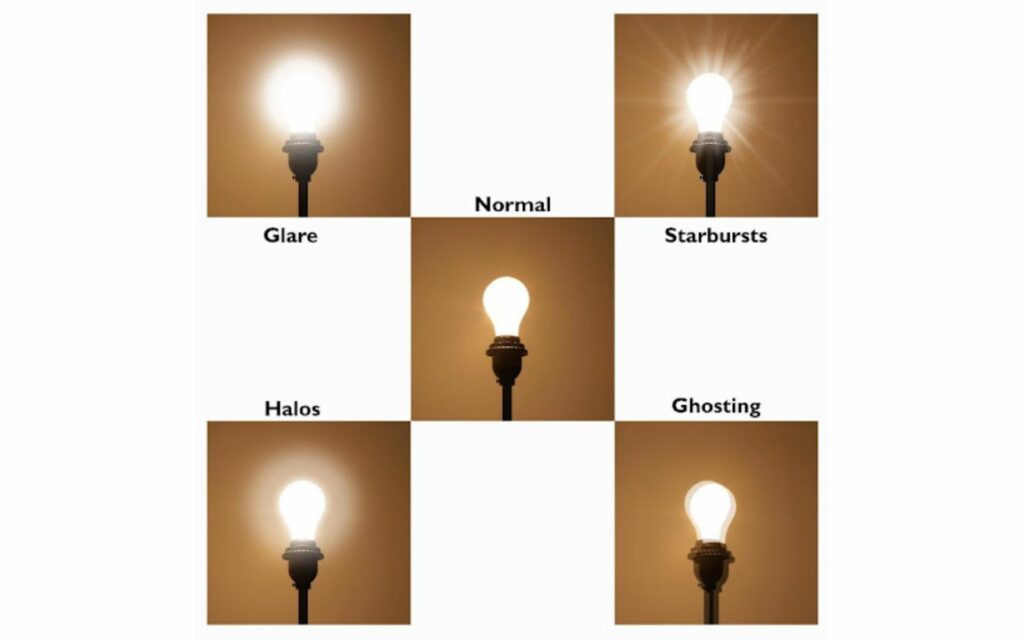
Cataract Surgery
Cataract surgery is an operation to remove your eye’s lens when it is cloudy. It is one of the most common surgeries performed in America and has a 90% success rate (meaning the patient’s quality of vision is improved to between 20/20 and 20/40 following the procedure).
The purpose of your lens is to bend (refract) light rays that come into the eye to help you see. Your own lens should be clear, but with a cataract it is cloudy like looking through a dusty or foggy car windshield. The surgery is relatively quick and painless and you will not see or feel the IOL after the procedure. During cataract surgery, your cloudy natural lens is removed and replaced with a clear artificial lens. This lens is called an intraocular lens (IOL). During your cataract pre-op exam, we will talk with you about IOLs and how they work.
Before Surgery:
Your eye will be measured to set the proper focusing power for your IOL. Also, you will be asked about any medicines you take. You might be asked not to take some of these medicines before surgery. You may be prescribed eyedrop medicines to start before surgery. These medicines help prevent infection and reduce swelling during and after surgery.
The Day of Surgery:
Cataract removal surgery may be done in an outpatient surgery center or in a hospital. You may be asked not to eat any solid food at least 6 hours before your surgery.
Here’s what will happen:
- Your eye will be numbed with eye drops or with an injection around the eye. You may also be given a medicine to help you relax.
- You will be awake during surgery. You may see light and movement during the procedure, but you will not see what the doctor is doing to your eye.
- Your surgeon will enter into the eye through tiny incisions (cuts, created by a blade or laser) near the edge of your cornea (the clear window on the front of your eye). The surgeon uses these incisions to reach the lens in your eye. Using very small instruments, he will break up the lens with the cataract and remove it. Then your new lens is inserted into place.
- Usually, your surgeon will not need to stitch the incisions closed. These “self-sealing” incisions eventually will close by themselves over time. A shield will be placed over your eye to protect it while you heal from surgery.
- You will rest in a recovery area for about 20 minutes. Then you will be ready to go home.
Days or Weeks After Surgery:
- You will have to use eye drops after surgery. Be sure to follow your doctor’s directions for using these drops.
- Avoid getting soap or water directly in the eye.
- Do not rub or press on your eye. Your optometrist may ask you to wear eyeglasses or a shield to protect your eye.
- You will need to wear a protective eye shield when you sleep.
- Your optometrist will talk with you about how active you can be soon after surgery. We will tell you when you can safely exercise, drive or do other activities again.
Like any surgery, cataract surgery carries risks of problems or complications. Here are some of those risks:
- Eye infection.
- Bleeding in the eye.
- Ongoing swelling of the front of the eye or inside of the eye.
- Swelling of the retina (the nerve layer at the back of your eye).
- Detached retina (when the retina lifts up from the back of the eye).
- Damage to other parts of your eye.
- Pain that does not get better with over-the-counter medicine.
- Vision loss.
- The IOL implant may become dislocated, moving out of position.
Posterior Capsular Opacification
Your vision could become cloudy or blurry weeks, months or years after cataract surgery. This is not unusual. Your doctor might call this a “posterior capsular opacification (PCO).” It’s also called “secondary cataract” or “scar tissue.” It’s not like a scar you get on your skin. But because it happens after the eye has healed from cataract surgery, some people think of it as a scar. It happens when a membrane called the posterior capsule becomes cloudy. It might help to think of the posterior capsule as a transparent pocket. It holds your IOL in place. It also once held your eye’s natural lens in place. If you notice cloudy vision again, you might need to have a laser procedure. The laser creates an opening in the cloudy capsule and is called a posterior capsulotomy (YAG laser capsulotomy). This procedure helps restore clear vision.
Cataract surgery will not restore vision lost from other eye conditions such as glaucoma, diabetic retinopathy, or macular degeneration. Your optometrist will talk with you about the risks and benefits of cataract surgery.
Cataract surgery costs are generally covered by Medicare if you are Medicare eligible. Private insurance usually covers cataract surgery as well.
Medicare will cover your costs if your vision tests at a certain level of acuity or clarity. Private insurance plans may have similar vision requirements. If your surgery is covered you may still have some costs. Special types of IOLs will cost more. Choosing to have cataract surgery before your vision has deteriorated enough will cost more.
In certain cases, it might be possible to get coverage before you meet the age or vision requirements. Talk with your optometrist if you are considering having early cataract surgery.
What do you do if you don’t have Medicare or private insurance coverage? You may still be able to reduce and manage the cost of cataract surgery. See if your employer offers flexible spending accounts that can help. We can help you learn more about costs of cataract surgery and discuss your options for affording the procedure.
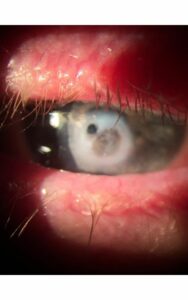 Corneal ulcers, or keratitis, is an open sore on the cornea, the clear window on the front of your eye. Ulcers commonly occur due to an eye infection, but sometimes can come from overwearing contact lenses, severe dry eye, or other eye disorders.
Corneal ulcers, or keratitis, is an open sore on the cornea, the clear window on the front of your eye. Ulcers commonly occur due to an eye infection, but sometimes can come from overwearing contact lenses, severe dry eye, or other eye disorders.
The best way to avoid corneal ulcers is to minimize the risk of eye injury by wearing suitable protective eyewear when playing sports or working, and by following proper contact lens care instructions to help prevent infections that may lead to further damage.
These are the types of infections that typically cause corneal ulcers:
Bacterial Infections: These are caused by growth of a harmful bacteria in the eye. Bacterial infections typically affect people that sleep in their contact lenses overnight.
Viral Infections: These occur from an impaired immune system and may be triggered by stress. Viral infections from the herpes simplex virus may cause recurring attacks that lead to ulcers.
Fungal Infections: These happen from improper contact lens use or certain types of eye drops. Injuries that resulted in plant material getting into the eye can also lead to fungal infections.
Parasitic (Acanthamoeba) Infections: Acanthamoeba are a tiny single-celled amoebas that typically live in freshwater and soil. When they get into the eye, they can cause severe infections, particularly for contact lens wearers.
Symptoms to watch for are:
Red eye
Severe pain or soreness
A white spot on your cornea
Feeling like something is in your eye
Excessive tearing
Discharge or pus
Blurred Vision
Light sensitivity
Swelling
We offer the latest, most effective dry eye treatments, including OptiLight IPL, BlephEx, and Biologics at Tarr Eye & Vision Center. As your optometrist in the Lakeway Area, we are experts in examining your eyes for dry eye disease and treating them in the best possible way.
Our treatments for dry eye range from prescription eye drops and punctal plugs to heat and light therapy to clear blocked meibomian glands and help get your eyes feeling great again.
During your next eye exam, Dr. Blake Tarr will examine your eyes to determine the best dry eye treatment for them.

Dry eye disease (DED) is an ongoing condition that treatments may be unable to cure. Yet the symptoms of dry eye, including dryness, scratchiness, and burning-can usually be successfully managed. Artificial tears, which are lubricating eye drops may alleviate the dry, scratching feeling and foreign body sensation of dry eye. Fortunately, we now have prescription eyedrops. Some work on each layer of the tear film, some work on increasing production and some work on improving the quality of the tears.
Check with Dr. Tarr before buying any over-the-counter eye drops. Many over the counter eye drops have harsh chemicals or preservatives which can be toxic to your cornea. Outdoors, wear wraparound sunglasses to block the effects of sun, dust and wind on dry eyes. Indoors, an air cleaner can filter out dust and other particles from the air, while a humidifier adds moisture to the air that is too dry because of heating or air-conditioning.
Dry Eye Treatment For Severe Cases
For more significant cases of dry eye, Dr. Tarr may recommend punctal plugs. These tiny devices are inserted in ducts in your lids to slow the drainage of tears away form your eyes, thereby keeping your eyes more moist and comfortable.
Dr. Tarr also recommends omega-3 fatty acids which helps heal your body from the inside out and has been proven to help with Dry Eye Disease.
If medications are the cause of dry eyes, discontinuing the drug generally resolves the problem. However, in this case, the benefits of the medicine must be weighed against the side effect of dry eyes. Sometimes switching to a different type of drug alleviates the dry eye symptoms while keeping the needed treatment. Concerning this, never discontinue or switch your medications without consulting with your doctor first.
Treating any underlying eyelid disease, such as blepharitis, helps as well. This may call for an antibiotic or steroid drops, plus frequent antibacterial eyelid scrubs.
If you are considering LASIK or Cataract Surgery, be aware that dry eyes may disqualify you for the surgery, at least until your dry eye condition is successfully treated. Dry eyes increase your risk for poor healing after surgery, so most surgeons will want to treat the dry eyes first, to ensure a good outcome.
How Can I Improve My Lifestyle To Prevent And Treat Dry Eye Syndrome?
Of the many ways you can treat dry eye, we first recommend preventing dry eye symptoms before they start. Address lifestyle factors that may be making dry eye worse!
- Blinking often will help renew your tear film to keep your eye moist and fresh.
- Staying hydrated is helpful and can relieve some of the dry eye symptoms as well.
- Check if any medications have dry eye side effects. There are many medications that can cause dry eyes such as Diuretics (water pills) for high blood pressure, Beta-blockers for heart problems or high blood pressure, Allergy and cold medicines (antihistamines), Sleeping pills, Anxiety and Anti-depressant medicines, and Heartburn medicines among others.
- Over the counter eye drops do bring relief to minor symptoms, and are widely available. During a dry eye exam, ask your eye doctor which specific brand of eye drops works best for your particular case of dry eye.
- Maintain a healthy diet with a focus on vitamins like Omega 3.
Dry Eye Syndrome can range from a mild irritant to chronic problem. The symptoms of Dry Eye Syndrome may include:
- Dry, irritated, or red eyes
- Excessive tearing/watery eyes
- Inflammation
- Sore or sensitive eyes
- Itchiness
- Burning or inflammation
- A gritty or pasty feeling in the eyelids
- Crusty or gunky eyes
- Blurriness
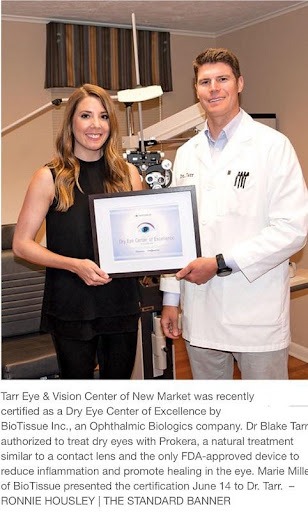
The Dry Eye Center of Excellence at Tarr Eye & Vision Center has been at the forefront of dry eye optometry in East Tennessee and is a leader in managing dry eye syndrome.
Glaucoma refers to a group of eye diseases that cause progressive damage to the eye’s optic nerve. Glaucoma is the second leading cause of blindness in the U.S. In most cases, there are no symptoms or vision loss until irreversible damage has already occurred which is why it’s called the “silent thief of sight.” However, prompt treatment in the early stages can prevent glaucoma.
There are 2 main types of glaucoma:
- Primary open-angle glaucoma: This type of glaucoma is the most common and occurs when the eye produces too much fluid or does not drain fluid properly. The inadequate draining causes the eye pressure, called intraocular pressure, to rise, damaging the optic nerve.
- Angle-closure glaucoma: This type of glaucoma is considered an eye emergency as it can happen suddenly and threaten your vision. Angle-closure glaucoma occurs when the iris is very close to the drain of your eye and suddenly blocks it. This causes intraocular pressure to rise very rapidly and can cause blindness.
Risk factors for glaucoma include age, diabetes, family history, race, corticosteroid use, and increased eye pressure. If glaucoma is diagnosed, topical or oral medication is prescribed by the doctor.
Blepharitis is inflammation of the eyelids categorized by red, irritated, itchy eyes. Dandruff-like scales can form on the eyelashes as a result of bacteria overgrowth or skin conditions, such as rosacea.
Blepharitis is an uncomfortable condition, but it’s not contagious. There are 2 main types of blepharitis:
- Anterior Blepharitis: This occurs at the outside edge of the eyelids where the eyelashes grow. Anterior blepharitis is commonly caused by bacteria or dandruff of the eyebrows and scalp.
- Posterior Blepharitis: This affects the inner edge of the eyelid that touches the eyeball. Posterior blepharitis occurs when the meibomian glands irregularly produce oil, creating a favorable environment for bacteria. This can also develop as a result of skin conditions, such as dandruff or rosacea.
We can diagnose blepharitis during a comprehensive eye exam. If diagnosed, we will develop a tailored treatment plan that best suits your needs and lifestyle.
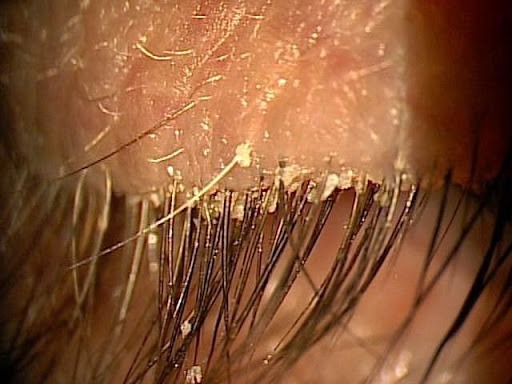
Demodex mites are 8-legged ectoparasites that live in our sebaceous glands and hair follicles. They are contracted and spread by direct contact or dust containing eggs. Typically, Demodex are found in and around the eyelashes and often cause:
- Irritated eyes
- Debris on the base of your eyelashes
- Loss of eyelashes
- Itchy, irritated eyelids (especially near the base of the eyelashes)
If Demodex mites are not properly managed, they can infest the eyelash follicles, resulting in inflammation, meibomian gland dysfunction, and other symptoms commonly associated with dry eye.
Treating Demodex infestations involve in-office treatments and lid scrubs. We will develop a treatment plan that involves proper lid and lash hygiene to prevent future overpopulation of Demodex mites.
If your meibomian glands are affected, once active inflammation has subsided, you can undergo Intense Pulsed Light (IPL) treatments to improve gland function.

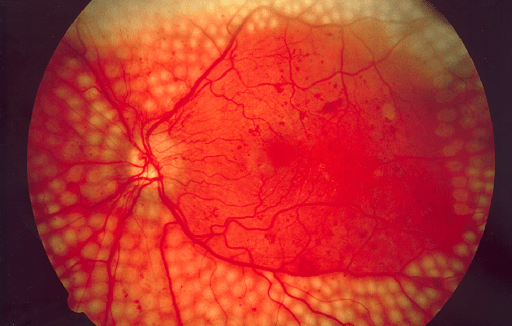
Diabetic retinopathy is a disease that can progress very quickly in people with diabetes. When blood glucose levels are uncontrolled, high amounts of damage can occur to the retinal blood vessels. High blood sugar levels can cause the blood vessels to swell and leak, or close completely. After this happens, abnormal blood vessels grow on the retina, which can burst and leak blood and other fluid into the eye.
There are 2 types of diabetic retinopathy:
- Non-proliferative diabetic retinopathy (NPDR): This is the early stage of diabetic eye disease. This stage can cause retinal swelling, which prevents blood from reaching and bringing oxygen to some parts of the eye. You may begin to notice significant vision loss with NPDR.
- Proliferative diabetic retinopathy (PDR): This is the more advanced stage of diabetic eye disease. PDR is characterized by the growth of new leaky blood vessels, which burst dumping fluid into the eye. PDR can also lead to glaucoma and retinal detachment due to scar tissue and should be treated promptly.
Symptoms of diabetic retinopathy include:
- Blurred vision
- An increased number of floaters
- Vision changes
- Dark or blank areas in your vision
- Poor night vision
- Colors appearing washed out or faded
- Dry, irritated eyes (see Dry Eye Risk & Diabetes)
How Does Diabetes Increase Your Dry Eye Risk?
Dry eye syndrome (DES) is of special concern to diabetics, who also have a higher risk of developing potentially sight-threatening eye conditions like diabetic retinopathy, macular degeneration, and glaucoma. People with diabetes are significantly more likely to suffer from DES for several reasons:
- Reduced corneal sensitivity:
The body produces tears in response to messages received from the cornea. However, this reflex tear production is disturbed when the nerves in the cornea are damaged and become less sensitive. If the eyes don’t realize that they’re dry, or if there’s a grain of sand in the eye, it will produce fewer tears.
- Prolonged course of diabetes medications:
Having diabetes from a younger age and being treated with diabetes medication can, over time, damage the lacrimal glands that provide the watery component of tears.
- Reduced tear production:
High blood sugar causes nerve damage to the glands producing the essential components of the tears. This results in decreased tear production or reduced tear quality, and eventually chronic dry eye symptoms.
Fortunately, complications that can cause dry eye syndrome and vision loss from diabetes are largely preventable with excellent blood sugar control. All diabetics should see an eye doctor at least once a year for a complete dilated eye exam. Early detection and treatment are essential.
Diagnosis and Treatment of Diabetic Dry Eye in Children and Adults
At Tarr Eye & Vision Center’s Dry Eye Center, we assist in treating dry eye syndrome in adults, children and adolescents with diabetes. Contact Tarr Eye & Vision’s Dry Eye Center in New Market, TN today to schedule a comprehensive eye exam.
Our practice serves patients from Morristown, Strawberry Plains, Dandridge, Kodak, and Jefferson City, Tennessee and surrounding communities.
Most likely you’ve experienced occasional visual “floaters” or flashes and may have wondered what they were and if they’re a cause for concern. They look like tiny lines, shadows, or specks that appear to be drifting in the visual field. More often than not, seeing floaters is a normal occurrence and does not indicate a problem with ocular or visual health. However, if you are noticing new floaters or more of them, or if you see more of them and they are accompanied by flashes of light, that can indicate a more serious problem.
The sudden appearance of these symptoms can mean that the vitreous is pulling away from your retina, a condition called posterior vitreous detachment (PVD), or it could mean that the retina itself may be developing a hole or tear in it. When the retina becomes dislodged from the back of the eye’s inner lining, which contains blood, nutrients and oxygen vital to healthy function, it is an eye emergency called a retinal detachment.
Floaters & Flashes Eye Care In Jefferson County, Tennessee
If you suddenly, or with increasing frequency, experience flashes or floaters, call Tarr Eye & Vision Center and schedule an eye exam with Dr. Blake Tarr right away to rule out any serious eye conditions.
What Causes Floaters?
The vitreous in the eye is a clear gel that fills most of the eyeball and resembles raw egg-white. Within the vitreous are small lumps of protein that drift around and move with the motion of your eyes. When these tiny lumps of protein cast shadows on the retina — the light-sensitive lining at the back of the eye — the shadows appear as floaters.
As we age, the vitreous shrinks, creating more strands of protein. This is why the appearance of floaters may increase with time. Floaters tend to be more prevalent in nearsighted people and diabetics, and occur more frequently following cataract surgery or an eye injury.
If seeing floaters becomes bothersome, try moving your eyes up and down or side to side to gently relocate the floaters away from your visual field.
What Causes Flashes?
Flashes result from the retinal nerve cells being moved or tugged on. As the vitreous shrinks over time, it can tug at the retina, causing you to “see stars” or bursts of light. The process of the vitreous separating from the retina is called “posterior vitreous detachment” (PVD) and usually isn’t dangerous.
In about 15% of cases, PVD causes tiny tears in the retina that can lead to retinal detachment — a sight-threatening condition that causes irreversible blindness if left untreated.
Other possible causes of flashes are eye trauma or migraine headaches.
When To Call Your Optometrist About Floaters
If you experience any of the following symptoms, promptly make an appointment with an eye doctor near you for emergency eye care.
Symptoms You Shouldn’t Ignore
- A sudden onset of floaters accompanied by flashes (which can be any shape or size)
- An increase of floaters accompanied by a darkening of one side of the visual field
- A sudden, noticeable decrease in vision
- Shadows in the peripheral vision
- A curtain moving across the field of vision
- Any time flashes are seen
In many cases, seeing floaters is no cause for concern; however, the above symptoms could indicate retinal detachment—which, if left untreated, could cause a permanent loss of sight or even blindness.
If the receptionist picks up the phone and hears the main concern is floaters or flashes, she will try to squeeze in the appointment within 24 hours. Expect the pupils to be dilated during your eye exam, so the eye doctor can get a really good look at the peripheral retina to diagnose or rule out a retinal tear or other serious condition, as opposed to a non-vision-threatening condition such as uncomplicated posterior vitreous detachment (quite common) or ocular migraine.
Can I Get Shingles In My Eye?
The virus known as herpes zoster, commonly known as shingles, can affect the eyes. It is caused when your body’s immunity to the childhood chicken pox virus (the varicella-zoster virus) breaks down. When you lose your immunity to the virus, it becomes reactivated. The virus then progresses along nerves and settles in a localized area somewhere in the body, causing a rash, itching and pain. The shingles’ rash can also result in small blisters called vesicles, which can rupture and cause scarring. Shingles can also result in numbness and long term pain called neuralgia.
If the herpes zoster virus settles in nerves in your nose, cheeks, or forehead, it may also affect your eyes. This can result in painful blisters on or inside of your eyelids. It’s also possible for shingles to impact your conjunctiva, the membrane covering the white of your eye, as well as your cornea. In the cornea, the virus can cause corneal abrasions which, if untreated, can lead to infections in your eye and corneal ulcers. The virus can also result in painful inflammation in your eye which is known uveitis or iritis. Because the virus travels along nerves, it can also impact your retina and optic nerve, although this happens less frequently. Any of these conditions, if left untreated, can result in loss of vision.
Symptoms of herpes zoster of the eye may include blisters, redness, pain or burning, itchiness and extreme skin sensitivity. This may also be accompanied by a headache, a fever and a general sense of not feeling well. You should see your eye doctor immediately if you experience one or more of these symptoms. Early detection and treatment is necessary to prevent potentially serious vision loss.
High cholesterol can cause significant damage to your eye health, so it is important to be aware of its effects on the eye. Cholesterol is a naturally-produced waxy substance that is important in maintaining different functions in the body.
High cholesterol can lead to narrowing of the arteries and veins and developments of blood clots, resulting in reduced blood flow. When the veins or arteries are blocked, blockages in the retina can occur, limiting vision.
There are many medications that are necessary for our health and well being which can have side effects related to our eyes. If you are taking one or more of these high risk medicines your family doctor may suggest a periodic eye examination. At Tarr Eye & Vision Center, we are prepared to assist you in this part of your medical eye care.
Accutane (Isotretinoin) and Dry Eyes
Isotretinoin, also known as Accutane, does a great job of reducing acne, but it has potential side effects that can affect the eyes. It works by decreasing the size of the oil glands that secrete oil onto the skin. By reducing the production of the facial oils, the pores become less clogged and the amount of acne diminishes.
As Accutane travels through the bloodstream, it also penetrates the eyelids’ meibomian glands (which produce the oil for tears), and suppresses their function causing the oil layer in the tears to diminish allowing excessive tear evaporation. This results in the eyes drying out.
A 2012 study published in JAMA Dermatology analyzed how isotretinoin effects the eye and concluded that taking Accutane puts patients at a significantly higher risk of experiencing many adverse ocular effects.
Commonly associated eye problems associated with acne medication were dry eye syndrome, contact lens intolerance, blepharitis, conjunctivitis, photosensitivity, and papilledema.
Fortunately, these effects are often temporary, and resolve within a few months after completing treatment. However, a study published in Optometry and Vision Science (2015), found that 1% of patients developed permanent meibomian gland dysfunction after taking isotretinoin.
How A Dry Eye Optometrist Can Help
Some dermatologists will refer their patients to an optometrist for a dry eye evaluation before prescribing isotretinoin to treat acne. If the patient already has signs of ocular surface disease or is taking other medications that interfere with tear production, the doctor may decide against prescribing isotretinoin.
We can help by thoroughly assessing your ocular condition to help your dermatologist determine the best acne treatment for you, as well as help you manage your dry eye symptoms.
If you or a loved one is currently taking or has taken isotretinoin and is experiencing symptoms of dry eye syndrome such as eye irritation or burning eyes, we can offer lasting treatment and solutions.
To schedule your dry eye consultation or learn more about our services, call Tarr Eye & Vision Center’s Dry Eye Center today.
Amiodarone (Cordarone)
Amiodarone (Cordarone) is a medicine used for cardiac arrhythmias. It is highly effective for rapid heartbeats. Amiodarone has been associated with corneal opacities. A characteristic ‘whorl’ is seen on the lower third of the cornea, the window to the eye. These are usually not visually significant, but in unusual circumstances Amiodarone may need to be discontinued if vision declines.
Flomax (Tamsulosin)
Flomax (Tamsulosin) is a medicine that is prescribed for the urinary symptoms associated with benign prostatic hypertrophy. Flomax has been associated with a problem that occurs during cataract surgery called the intraoperative floppy iris syndrome (IFIS). During cataract surgery the iris, or color part of the eye, becomes very floppy and billows in response to the normal irrigation currents during cataract surgery. In addition, the pupil will also constrict during cataract surgery, dramatically reducing the surgeons view. Unfortunately, discontinuing Flomax prior to cataract surgery does not prevent IFIS. However, it is vitally important that you tell Dr. Blake Tarr that you are taking Flomax. Since IFIS can lead to a greater chance of complications during cataract surgery the doctor will discuss this with you at length. Special steps may be necessary prior to surgery and during surgery in an attempt to reduce the likelihood of complications.
Tamoxifen (Nolvadex)
Tamoxifen (Nolvadex) is a breast cancer medicine that has been associated with several different types of retinal side effects. These may include swelling in the macula, changes in the pigment in the macula, and inflammation in the retina associated with hemorrhages. All of these problems can lead to significant visual loss. Tamoxifen has also been associated with optic nerve problems. Discontinuing Tamoxifen is usually associated with full visual recovery.
Plaquenil
Plaquenil (Hydroxychloroquine sulfate) is an oral medication originally taken to prevent or treat malaria. Now the drug is used to treat inflammatory diseases. This type of disease occurs when the body’s immune system attacks its own healthy tissue. Some diseases treated with Plaquenil include:
- Lupus – which causes rashes, fever, skin problems, and other symptoms
- Rheumatoid Arthritis – a condition which causes pain and swelling in the joints of your feet and hands.
- Sjogrens syndrome – which causes dry eyes and dry mouth.
Plaquenil lowers your immune system’s ability to cause inflammation. This can help control symptoms like rashes, skin and mouth sores and joint pain.
Plaquenil can cause irreversible changes in the macula, the center of the retina. Dr. Blake Tarr will examine the macula for signs of Plaquenil toxicity. Using Plaquenil for a long period of time may harm the retina, causing serious vision loss.
People with retinal damage from Plaquenil are not aware at first that they are losing vision. Unfortunately, once they lose a severe amount of vision, it is permanent. If you take Plaquenil, it is essential to have a dilated eye exam at least once a year with your eye doctor.
Steroids
Steroids (such as Prednisone, Dexamethasone, Decadron, and others) are useful in treating many different types of diseases. Whether these medications are used topically as eye drops or taken in pill form or injected, they have been associated with elevated pressure in the eye (which can cause glaucoma), and cataracts. The risks of these side effects is significant, and most patients will need to be seen periodically by an eye doctor while they are taking steroids. If the steroids are being used to treat a significant health or life threatening disease, your Tarr Eye & Vision Center doctor will usually opt to treat the side effects so that you can continue to take this very important medicine.
Interferon
Interferon is a relatively new medicine, which is used to treat hepatitis, organ transplant rejection, and certain types of cancers. Interferon has been associated with inflammation on the optic nerve called optic neuritis, as well as inflammation in the retina called retinitis. These problems will usually resolve simply by stopping the Interferon.
Viagra
Viagraand similar medications have been associated with some visual side effects and recently have been associated with vision loss. Viagra is a medicine used to treat erectile dysfunction by changing the dilation characteristics of certain blood vessels in the body. Men who take Viagra occasionally notice a blue tint to their vision while the medicine is active. Recently there have been accounts of vision loss associated with non-arteritic ischemic optic neuropathy, essentially a stroke to the optic nerve. At this time, it is uncertain if Viagra and associated medicine like Cialis are in any way a cause of this vision-threatening problem. The blood vessel problems responsible for NAION are similar to the blood vessel problems which are found in men with ED. If you or anyone you know should be experiencing vision changes while taking Viagra they should be urged to discontinue this medication and see an eye doctor as soon as possible.
Gilenya
Gilenya (Fingolimod) was approved by the FDA to treat relapsing forms of MS. It is administered as a once-per-day 0.5mg capsule. Gilenya is the first approved oral disease modifying treatment for MS. Combined data from a Phase II study and two Phase III trials showed that Gilenya reduces relapses, disability progression, MRI lesion activity, and brain atrophy progression (loss of brain tissue). Gilenya is generally safe and well tolerated. One of the possible side effects from this medication is macular edema (fluid swelling of the retina in the back of the eye) that causes blurred vision. This rarely occurs and usually it develops within 3-6 months after starting Gilenya. It will improve with discontinuation of Gilenya. Patients will be required to have an eye exam including a test called optical coherence tomography (OCT) prior to starting Gilenya, and 3-4 months after starting treatment. Patients with diabetes and uveitis are at increased risk for macular edema from Gilenya.
Similar to diabetic retinopathy, hypertensive retinopathy also affects the blood vessels in your eye. Caused by high blood pressure, the retina’s blood vessel walls can thicken, restricting blood from reaching the retina.
Lack of blood flow can cause the retina to swell, limiting its function. Over time, high blood pressure puts stress on the optic nerve, creating vision problems.
Likely, you won’t notice any symptoms of hypertensive retinopathy until the condition has progressed significantly. Symptoms of hypertensive retinopathy include:
- Reduced vision
- Swelling
- Burst blood vessels
- Double vision
- Headaches
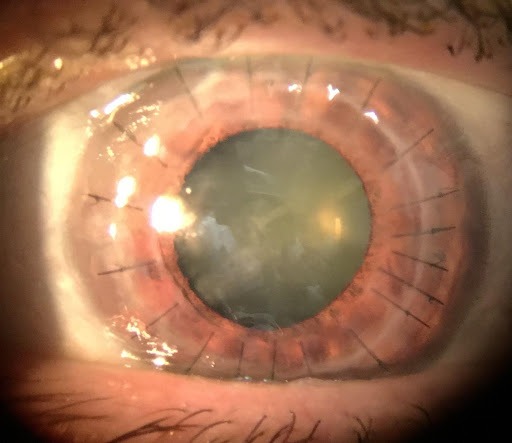 Keratoconus is when the normally round cornea thins and becomes cone shaped. As the cornea changes shape, it changes the way light rays are focused on the retina. As a result, vision becomes blurry and distorted. Keratoconus often begins in the late teen years and symptoms slowly progress for 10 to 20 years.
Keratoconus is when the normally round cornea thins and becomes cone shaped. As the cornea changes shape, it changes the way light rays are focused on the retina. As a result, vision becomes blurry and distorted. Keratoconus often begins in the late teen years and symptoms slowly progress for 10 to 20 years.
What Causes Keratoconus?
In patients with keratoconus, collagen fibers in the corna become weak and cannot hold the shape of the cornea. The exact cause is unknown, but research points to an increase in free radicals and in some cases genetics.
Keratoconus is also associated with excessive rubbing of the eyes, chronic eye irritation, and overexposure to UV light. It’s believed that excessive rubbing of the eye can damage corneal tissue, making symptoms worse.
Keratoconus Symptoms
- Blurry or distorted vision
- Increased glare and sensitivity to light
- Rapidly changing glasses prescription
- Redness or swelling of the eyes
- Difficulty wearing contact lenses
Treating Keratoconus
Treatment varies depending on your symptoms. In the initial stages, glasses or special contact lenses may be used to correct vision. As symptoms progress, other treatments may be necessary.
- Intacs – FDA approved small plastic arcs that are surgically inserted into your cornea. Intacs flatten the curve of your cornea returning it to a more natural shape.
- Collagen Cross-Linking – This procedure uses a special UV light and eye drops to strengthen and flatten the collagen fibers in your cornea. This stabilizes your cornea preventing the keratoconus from getting worse.
- Corneal Transplant – As a last resort, all or part of your cornea can be replaced. This is reserved for the most severe cases.
Conjunctivitis, also known as “pink eye,” occurs when the conjunctiva – the clear, thin layer lining the white (sclera) of the eye – swells up, causing the eye to appear red. This reddish appearance is due to the inflamed blood vessels in the sclera. Conjunctivitis commonly occurs as a result of infection or allergies, and some types are extremely contagious. If you suspect you may have pink eye, call your optometrist right away for prompt treatment. While pink eye is a mild eye emergency, delayed treatment can lead to vision or ocular damage.
- Viral conjunctivitis is caused by a virus. This type is very contagious and can spread very quickly through schools and workplaces.
- Bacterial conjunctivitis is caused by an overgrowth of bacteria. This bacterial infection is also very contagious and is categorized by an excessive amount of sticky discharge. Treatment for bacterial eye infection is vital because, if left untreated, it can result in severe vision damage.
- Allergic conjunctivitis is caused by eye allergens or irritants, such as pollen, dust, or pet dander. Allergic conjunctivitis is not contagious and will make your eyes itchy, watery, and puffy.
- Chemical conjunctivitis is caused by chemicals that lead the eye to become swollen and irritated. Common chemical irritants include chlorine (in a pool), smoke, fumes, air pollution, and other non-toxic chemicals. This type is not contagious, and responds well to flushing the eye with water or a sterile eye irrigating solution to remove the chemical.
Symptoms of pink eye include:
- Burning, itchy eyes
- Gritty feeling in the eye
- Light sensitivity
- Pain or soreness
- Watery eyes
- Puffy, swollen eyelids
- Blurred vision
- Excessive amounts of pus or discharge
Anyone can get pink eye, but these simple precautions can help you dramatically lower your risk.
- Frequently wash your hands with warm water for 30 seconds
- Never share items such as makeup, washcloths, hand towels, or eyeglasses
- Avoid rubbing your eyes
- Wear goggles when swimming
- Replace contact lenses as directed
- Regularly sanitize handheld devices and household surfaces
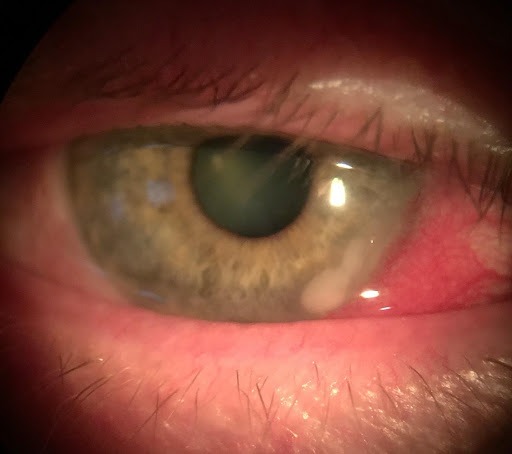
Eye allergies (or allergic conjunctivitis) are a common eye condition. When your eyes come into contact with an allergen, like pollen, your body’s defense system (immune system) works to attack the allergens by releasing histamines. This causes your eyes to become red and swollen (inflamed). People who are prone to suffer from other allergies are more likely to experience eye allergies, too.
What Causes Eye Allergies?
Some of the most frequent causes of allergies are:
- Seasonal Eye Allergies – certain seasons can be challenging for people who are allergic to tree, grass, and weed pollens. Typically, these are more pronounced in the Spring, but they can occur at other times of the year as well.
- Year round or perennial conjunctivitis – people with allergies to pet dander, dust mites, and indoor allergens may experience eye allergy irritation throughout the year.
- Contact Conjunctivitis – your eye has a natural balance and when something comes in contact with the eye, it can disrupt that balance and cause contact conjunctivitis. This could be make-up, perfume, medications, or even wind blown objects. It may take three or four days after contact for symptoms to appear.
- Giant Papillary Conjunctivitis (GPC) – this is an allergic reaction to contact lenses. Contact lenses can be contaminated by poor handling (not washing hands) or when the cases or solutions used with contact lenses become contaminated. Good contact lens hygiene can help prevent this.
Eye Allergy Symptoms
- Itchy Eyes
- Irritated, red eyes
- Swollen eyelids
- Light sensitivity
- Tearing
- Soreness, pain, or burning
Treating Eye Allergies
Try to avoid those things that cause your eye irritation. Since that is not always possible, there are several medications available to help provide relief from eye allergies.
Prevention Tips:
- Minimize indoor triggers
- Wash your hair before going to bed. Many allergens can get trapped in your hair and then on the pillow case.
- Wash your bedding more often and use hot water
- Consider using allergen-reducing bedding
- When cleaning inside, instead of dry dusting or sweeping, use a wet mop or rag to trap allergens
- If you are allergic to pet dander, consider replacing carpet with hard surface flooring
- Most household cleaners contain harsh chemicals that can cause eye irritation, consider natural cleaners instead.
- Avoid Outdoor Triggers
- When pollen counts are high, stay inside
- Keep windows closed in your car and home
- Wearing glasses can help keep pollen out of your eyes
- Don’t rub your eyes! Rubbing your eyes can actually irritate them more and potentially introduce new allergens
When prevention alone isn’t enough, allergy medications can provide relief:
- Artificial tears can be used to temporarily wash away allergens
- Over the counter or prescription antihistamine eye drops
- Over the counter or prescription decongestants
- Oral antihistamines
- Steroids
- Allergy shots
If you suffer from eye allergies and have struggled to find relief, you could have more than just eye allergies. Dr. Blake Tarr can provide a comprehensive eye exam and provide you with options for relieving eye irritation. Call or text us to schedule and eye exam at (865) 475-6565.
What is Thyroid Eye Disease?
Thyroid eye disease (TED), also called Graves’ ophthalmopathy or Graves’ Eye Disease is an autoimmune disease in which the immune system causes inflammation and swelling and stimulates the production of muscle tissue and fat behind the eye. If the eye is pushed far enough forward, the eyelids may not close properly when blinking and sleeping. The front part of the eye, called the cornea, may become unprotected, dry and, damaged. Also, the enlargement of the tissues and muscles of the eye may prevent it from working well, which affects eye position and eye movements leading to double vision. In severe cases, the inflammation and enlargement of the tissues, muscles, and fat behind the eye compresses the optic nerve, the nerve that connects the eye to the brain, causing vision loss.
Who is at Risk for Thyroid Eye Disease?
Typically, an overactive thyroid gland causes TED; however, TED can occur with normal or even low levels of thyroid hormones. Thyroid eye disease can occur in patients who already know they have thyroid disease, or it may be the first sign of Graves’ disease. While TED often occurs in people living with hyperthyroidism or Graves’ disease, it is a distinct disease and treating hyperthyroidism may not resolve the eye symptoms and signs.
Other risk factors for thyroid eye disease include:
- Age: Usually affects middle-age adults but can occur at any age
- Gender: Females are affected more than males
- Family history of thyroid eye disease
- Smoking: Smoking increases the risk of thyroid eye disease by 7–8 times, causes thyroid eye disease to have a longer “active phase”, and it reduces the effectiveness of treatments
- Radioactive iodine therapy: Radioactive iodine has been used to treat hyperthyroidism and Graves’ disease. This treatment should be used with caution in people with active thyroid eye disease as it may worsen the condition unless steroids are given at the same time
- Low blood levels of selenium, a dietary mineral.
What are the Symptoms of Thyroid Eye Disease?
Symptoms of thyroid eye disease are caused by the tissues, fat, and muscles of the eye socket swelling and pushing the eyeball forward. It may be possible that symptoms may appear in one eye more than the other. The symptoms of thyroid eye disease include:
- Dry, gritty and irritated eyes
- Red eyes
- Watery eyes
- Puffy eyelids
- Sensitivity to light
- Bulging eyes (startled or staring appearance)
- Trouble moving eyes and closing eyes
- Inability to completely close your eye causing a corneal ulcer
- Colors appear to be dull or not as bright
- Blurred, Double or loss of vision due to optic nerve compression or corneal damage
How is Thyroid Eye Disease Treated / Managed?
Thyroid eye disease in its active phase can last between one and three years. That means if it is left untreated, the inflammation may gradually decrease by itself but may cause damage to vision through the course of the disease. Sometimes, the changes caused by the enlargement of the tissues (such as bulging eyes or double vision) may not go away. The goal of treatment is to limit inflammation and swelling occurring during the active or inflammatory phase and to protect the front of the eye and prevent vision loss.
Dr. Blake Tarr is a Thyroid Eye Disease specialist, trained in the latest treatments for managing TED. He will work closely with your endocrinologist and primary care physician who will manage any underlying thyroid problems you may have.
If a thyroid issue is suspected, evaluation and treatment are critical. The first priority is to restore your normal thyroid function. In addition, eye conditions should be examined and treated at the same time as your thyroid gland treatment. Eye problems may continue to progress even after your thyroid function returns to normal.
New Treatment: There is a new FDA-approved medication called Tepezza that is effective in treating thyroid eye disease. It is done by an intravenous infusion (putting drugs into a vein). Over 14,000 patients have been helped by this new medicine.
Prisms: Thyroid eye disease can cause scar tissue to develop in your eye muscles. This can lead them to become short and pull your eyes out of alignment, causing double vision. If double vision occurs, glasses containing prisms may be prescribed by your doctor. However, prisms do not work for all people with double vision and your doctor may recommend patching one eye for temporary relief or eye muscle surgery as a more effective option when changes have stabilized.
Orbital Decompression Surgery: Thyroid eye disease can cause swollen tissues around the eye that compresses the optic nerve. The optic nerve provides the connection between your eye and the brain. When the nerve is compressed, color vision becomes abnormal, lights may seem dimmer than usual, and the sharpness of the vision decreases. Orbital decompression surgery can be done to improve your vision. The surgery makes the eye socket bigger or removes some of the excess tissue. When the nerve is compressed, the goal of surgery is to get the eye and the inflamed tissue more space and decreases pressure on the optic nerve. Even when the optic nerve function is not compromised, orbital decompression may be used to restore comfort and appearance by reducing the bulging of the eyes. If orbital decompression surgery is recommended, it is usually performed prior to eye muscle surgery and/or eyelid surgery, if needed.
Thyroid Eye Disease is on the rise, but we are prepared to treat it with the most advanced medical care. Our optometrist specializes in treating thyroid eye disease and will provide a game plan for restoring clear, comfortable vision.
These at home therapies for thyroid eye disease, can help soothe your eyes and improve your vision:
Home TED Therapies
Cool compresses: Apply cool compresses to your eyes. The extra moisture and cooling effect may provide relief.
Sunglasses: When you have thyroid eye disease, your eyes are more sensitive to sunlight and UV rays. Wearing sunglasses helps protect them from both sun and wind.
Lubricating eye drops: Use lubricating eye drops, like artificial tears. It may help relieve dryness and scratchiness. Make sure to use eye drops that do not contain redness removers or toxic chemical preservatives such as BAK. Lubricating gels can be used before bed to prevent the cornea (the front of the eye) from drying out because your eyelids may not close completely when sleeping.
Eyelid Taping: Talk with your doctor about taping your eyelids together to help protect your front of your eye (cornea) from drying when your eyelids do not close completely during sleep. If you have difficulty closing your eyelids, you may be at risk to develop a corneal ulcer. The cornea is a clear layer that covers the front of the eye. A corneal ulcer is an open sore on your cornea and it can cause scarring and permanent loss of the vision. A corneal ulcer causes redness of the eye, pain and usually a decrease in vision. You should seek immediate attention from your eye doctor for these problems.
Elevate your head when laying down: Keeping your head higher than the rest of your body may reduce swelling and may help relieve pressure on your eyes.
Quit smoking: Smoking (and second hand exposure to smoke) is an important risk factor for thyroid eye disease. If you smoke, quit, and avoid second hand smoke.
Selenium supplements: Recent studies suggests that patients with mild active thyroid eye disease may benefit from selenium supplements. Talk to your doctor before starting supplements.
Before
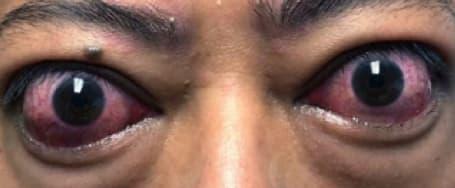
After Treatment
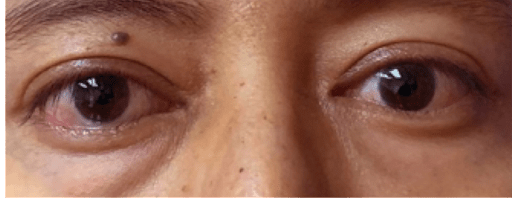
Uveitis is swelling or inflammation of the inner layers of the eye. The swelling can be located in the front, middle, back or all segments of the eye. The symptoms each patient experiences may vary depending on the location affected. Uveitis can be serious and lead to permanent vision loss. That is why it is important to diagnose and treat uveitis as early as possible, ideally before irreversible damage has occurred. Uveitis causes about 30,000 new cases of blindness each year in America.
What Causes Uveitis?
Uveitis is a form of inflammation of the eye. The cause of uveitis is often unknown in at least one-third of cases. The inflammation could be caused by:
- Eye injury or surgery
- Infection
- Autoimmune diseases or systemic inflammatory disorders that affect the whole body
Causes of Anterior Uveitis
In more than thirty-three percent of anterior uveitis cases, the exact cause is unknown but may include:
- Ankylosing spondylitis
- Reactive arthritis
- Psoriatic arthropathy
- Inflammatory bowel disease
- Juvenile idiopathic arthritis (JIA)
- Herpes
- Sarcoidosis
- Fuch’s heterochromic iridocyclitis
- Lupus
- Intraocular lens surgically implanted to replace a cataract lens
- Posner-Schlossman syndrome (PSS)
- Rheumatoid arthritis
- Syphilis
- Tuberculosis (TB)
- Lyme disease
Causes of Intermediate Uveitis
In more than sixty-seven percent of all cases of intermediate uveitis, the exact cause is unknown. The remaining third of all cases are thought to be caused by conditions such as:
- Sarcoidosis
- Multiple sclerosis (MS)
- Lyme disease
Causes of Posterior Uveitis
In more than ten percent of cases of posterior uveitis the cause is unknown. The following is a list of common causes of posterior uveitis.
- Toxoplasmosis
- Cytomegalovirus retinitis (CMV retinitis)
- Lupus
- Birdshot retinochoroidopathy
- Sarcoidosis
- Acute retinal necrosis
- Epstein-Barr virus (EBV)
- Behcet’s disease
- Syphilis
- Acute posterior multifocal placoid pigment epitheliopathy (APMPPE)
- Serpiginous choroidopathy
Causes of Panuveitis
As with other kinds of uveitis, the cause of panuveitis is often unknown. Other possible causes include:
- Sarcoidosis
- Behcet’s disease
- Lupus
- Syphilis
- Vogt-Koyanagi-Harada syndrome
- Tuberculosis (TB)
- Fungal Retinitis
Causes of Uveitis in Children
Often, the cause of the uveitis is unknown. Juvenile idiopathic arthritis (JIA) is a leading cause of uveitis in children.
- Juvenile idiopathic arthritis (JIA)
- Toxoplasmosis
- Toxocariasis
- Sarcoidosis
- Vogt-Koyanagi-Harada syndrome
- Acute retinal necrosis
- Reactive arthritis
- Lupus
- Behcet’s disease
- Fuch’s heterochromic iridocyclitis
- Chicken pox
What Are The Symptoms of Uveitis?
Uveitis symptoms may occur quickly in an acute form (lasts less than six weeks) or slowly in a chronic form (lasts longer than six weeks). These symptoms may get worse fast, and also may affect one or both eyes.
The signs and symptoms of uveitis include:
- Eye redness
- Eye pain
- Light sensitivity
- Blurred vision
- Dark, floating spots in your field of vision (floaters)
- Decreased vision
Anyone suffering from the symptoms above should immediately be examined by an eye doctor.

Meibomian gland dysfunction (MGD) is among the leading causes of dry eye disease and it affects millions of people around the world. Often reported symptoms are watery and burning eyes, fluctuating or blurry vision, and inability to wear contact lens or eye makeup. The most common type of MGD is obstructive MGD, which occurs when the glands become clogged, stopping the meibum from reaching the eye’s surface. At Tarr Eye & Vision Center we use the OptiLight IPL treatment, an FDA approved procedure to treat MGD.
The meibomian glands secrete an oil called meibum. Meibum (oil), aqueous tear (watery layer), and mucin (mucus) make up the three layers of the tear film. The meibum/oil stabilizes the tear film and prevents it from evaporating too quickly. A healthy tear film is required to keep your eyes moist and comfortable.
Spending long hours on digital devices (not blinking enough), wearing contact lenses, and using eyelash extensions or false eyelashes can all contribute to developing MGD.
Certain medical conditions can also cause MGD, such as:
- Eyelid infections
- High cholesterol levels
- Conjunctivitis
- Eyelid inflammation (blepharitis, Demodex)
- Skin disease (acne, rosacea, atopic and seborrheic dermatitis)
Additionally, some medications can cause a reduction in meibum production, such as glaucoma medications, estrogen replacement therapies, and retinoids commonly found in acne medication and anti-aging creams.
